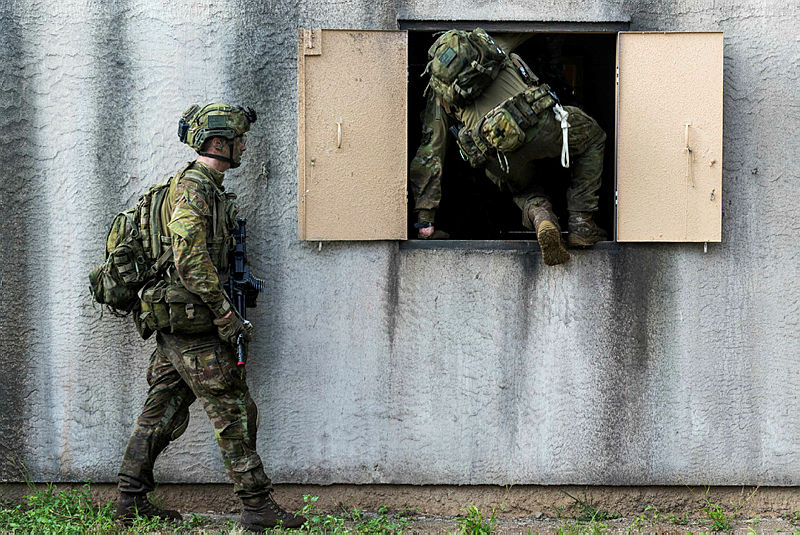
Bob Moyse’s recent piece for The Strategist raises a number of issues that are vital for the future of Australia’s security. He argues that debates about force structure have, until recently, largely been focused at the tactical level.
This has resulted, he argues, in ‘an incoherent force structure’ that has been ‘winning battles and losing wars’, and a mismatch between the capabilities of the different branches of the defence force. In his view, there hasn’t been enough coordination between the services—each advocates a force structure fitting its tactical needs, but without thought for the way it will fight a war in conjunction with the other services.
His article implies that my support for the Department of Defence’s Project LAND 400 is the exact kind of problem he describes: a focus on tactical matters that neglects higher levels of warfare. But this is a serious mischaracterisation. My last Strategist article criticised the ‘lack of integration in our approaches to the tactical and strategic levels of defence’ and called for exactly the opposite of what Moyse criticises me for, a harmonisation of strategy and tactics.
Focusing on tactics with no regard for strategy generates obvious problems, and I have often pointed those out. But it’s critically important to keep tactical considerations in mind when thinking about operations and strategy. Moyse has overstated the differences between our positions—we both want to see more coordination between the different levels of warfare in Australian defence planning.
Where we may differ is in our views of the best way forward for Australian defence planning. Moyse looks to Defence’s first principles review as a means of getting away from force-structure planning derived from the tactical considerations of a single service. This, he hopes, will encourage more consideration of operational and strategic factors in future force-structure planning.
My own view for some time has been that Australia needs to move towards a holistic security strategy directed much more specifically by government. That must start with an acknowledgement of the principal threats to Australia in a changing strategic environment. As Crispin Rovere said in relation to the 2016 defence white paper:
It is beyond question that the American-led global order has been unambiguously good for Australia and the world. The US has been a more restrained, universalist, and inclusive hegemon than any historical comparator. It is no accident the American era coincides with unprecedented advancements in every metric of human progress. But we must be honest with ourselves. China’s determination to expel the US from Asia is absolute, and the ‘established rules-based order’ is coming to an end.
The problem now is that US capability no longer matches what its allies have always assumed, and so US allies now need to seriously step up. The question Australia needs to answer is: do we persist with a strategy that hopes the US will come to our aid when we know that US intent and capability are being called into question, or do we proceed to a real level of independent capability while remaining within the alliance?
Linked to the evolving threat would be an examination of the strategic, operational and tactical requirements of the ADF in relation to the most probable future challenges it faces. The analysis must go beyond purely military concerns to include social and economic factors that could affect Australia’s ability to fight a future war. That can only be done by government. The idea is that Australia needs to work towards a truly integrated defence strategy that is future-focused and based on a realistic assessment of the security challenges we face.
At present, the fundamental problems are that Australia doesn’t have a comprehensive national security strategy despite a relatively good level of defence spending, and there’s only limited consensus on the main security challenges we will face in the years to come. That uncertainty affects all aspects of the force-structure debate and is a major impediment to getting the right security and defence strategies in place. It means that we’re not working from a consistent set of assumptions about how to fight, where to fight, who can fight, or how long we can fight for. As a result, we have no agreement about what to buy in order to win a fight. This has been a deficiency in every defence white paper since 1976, where tactics and procurement have never been linked to an overarching strategy.
I have some sympathy with Moyse’s view that we’ve been ‘winning battles and losing wars’, but let’s remember that Australia hasn’t been in many ‘battles’ above the very lowest tactical level since Vietnam. Moyse may be able to substantiate the claim that the West as a whole has won more battles than wars, but this is of limited relevance to Australia, which has never been responsible for leading wars itself. So he’s wrong to say that ‘an incoherent force structure’ and a mismatch between the capabilities of the different branches of the ADF has had anything to do with ‘losing wars’.
Australia and the larger coalition forces that we’ve been part of haven’t been successful in winning wars because we (meaning both Australia and its partners) haven’t had a strategy to invest a sufficient number of tactical forces for a sufficient time to give us a chance of ‘winning’. But that is a much bigger issue.

